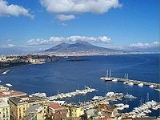
. Lying between two notable volcanic regions, Mount Vesuvius
and the Phlegraean Fields
, it is the capital of the region of Campania
and of the province of Naples
. Naples is known internationally for its rich history, art, culture, architecture, music, and gastronomy, and has played an important political and cultural role both within and beyond the Italian peninsula throughout its 2,800-year existence.
Founded around the 9th century BC as a Greek colony, Naples is one of the oldest continuously inhabited cities in the world.
1266 Battle of Benevento: An army led by Charles, Count of Anjou, defeats a combined German and Sicilian force led by King Manfred of Sicily. Manfred is killed in the battle and Pope Clement IV invests Charles as king of Sicily and Naples.
1343 A tsunami, caused by the earthquake in the Tyrrhenian Sea, devastates Naples (Italy) and the Maritime Republic of Amalfi, among other places.
1494 Alfonso II becomes King of Naples.
1495 King Charles VIII of France enters Naples to claim the city's throne.
1504 France cedes Naples to Aragon.
1516 The Treaty of Noyon between France and Spain is signed. Francis I of France recognises Charles's claim to Naples, and Charles V, Holy Roman Emperor recognises Francis's claim to Milan.
1590 Carlo Gesualdo, composer, Prince of Venosa and Count of Conza, murders his wife, Donna Maria d'Avalos, and her lover Fabrizio Carafa, the Duke of Andria at the Palazzo San Severo in Naples.
1629 An earthquake in Naples, Italy, kills about 10,000 people.
1762 Great Britain declares war on Spain and Naples.
1906 Mount Vesuvius erupts and devastates Naples.

